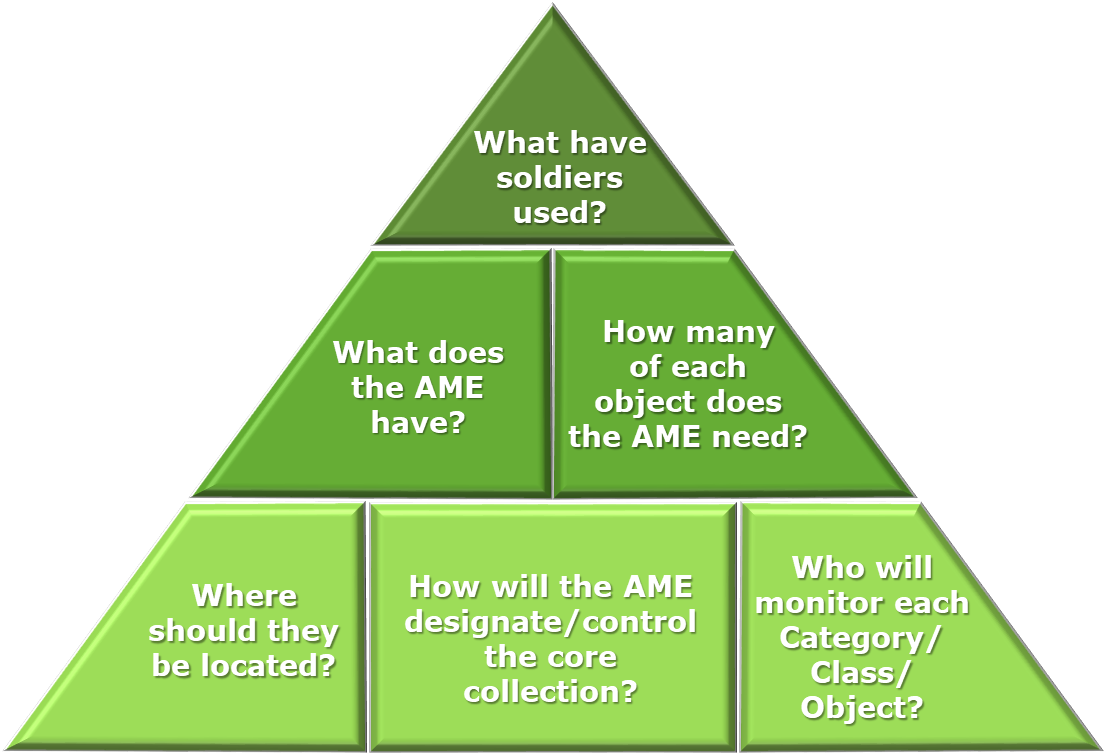Welcome to the AME Arms and Ordnance Portal
The Amy Museum Enterprise (AME) Chief for Arms and Ordnance provides services related to artifact collections associated with Small Arms Light Weapons (SA/LW), Ordnance, Ammunition and Explosives (AE), and Edged Weapons. The intent of the Arms and Ordnance Portal is to augment communication between the AME Headquarters and stakeholders across the AME and Army by making available a broad array of information and resources.
All questions and comments are welcome! Please explore the portal content where you will find a wealth of information regarding Arms and Ordnance.
Policy & SOP
Ordnance
Arms & Ordnance SOPs Ordnance
- Painting & Marking of Vehicle & Equipment [PDF 61KB]
- U.S. Army Aircraft Paint Color Guides [PDF 576KB]
- Tanks Manuals COMBAT FULL TRACKED M-60; M-60A1; M-60A2; M-60A3 [PDF 54KB]
HQDA EXORD 238-20 Conversion and Transfer of Excess Historical Combat Equipment to OHM
The full EXORD is available on milSuite and provides details of the process https://www.milsuite.mil/book/docs/DOC-840042
OHM Display Considerations:
Activities, units, and garrisons across the Army who obtain Organizational Heritage Materiel (OHM) IAW the HQDA EXORD 238-20 Conversion and Transfer of Excess Historical Combat Equipment to OHM, may be faced with exhibit challenges. Activities are not required to maintain OHM using professional museum standards IAW the AR 870-20 Army Museums, Historical Artifacts, And Art. However, planning ahead and preparing appropriate areas for display are essential to creating safe and historically accurate displays.
Safety:
Safety is paramount for Soldiers, families, and visitors. Signs prohibiting climbing on vehicles should be placed in conspicuous locations to prevent accidental injury to persons around vehicles. Viewer-control posts with ropes are good options to prevent access. All hatches on tracked vehicles should be secured and locked to prevent entry. Tack-welding is the most secure method. All openings should be vermin proofed to prevent nesting. Signs can be obtained/purchased through a contractor or from the local activity's graphic or sign shop. NOTE: Obtaining services related to OHM are the responsibility of the unit/recipient. The Center of Military History or Army Museum Enterprise does not provide these services.
Abatement:
If not previously performed, OHM require abatement to protect Soldiers, families, visitors, and the environment from hazardous materials. Submit a request for information regarding abatement.
OHM Care, Maintenance, and Painting:
While not required, OHM should be placed on a concrete pad engineered to move water away from the vehicle. If a concrete pad does not already exist, plan ahead with the local Logistics Readiness Center (LRC) to create a surface strong and large enough for the OHM. Erecting a protective cover against rain and direct sunlight can extend the life of OHM paint. Submit a request for information regarding concrete pad construction specifications. Placing cannon or vehicles with pneumatic tires on steel supports/mounts at the axles will prevent the tires from warping. Painting the display OHM with the correct color for the time period is important for historical accuracy. Refer to Historical Army Vehicle Paint Information for OHM. For fixed-wing and rotor-wing aircraft paint guides, refer to the U.S. Army Aircraft Paint Color Guides. When applying tactical markings, numbers, or insignia, refer to Bumper Numbers and Letters.
Collections
Arms & Ordnance Collections-Small Arms & Light Weapons
- TM E9-206A MG-34 (Apr 1943) [PDF 1.05MB]
Ordnance
- FM 21-6 List of Publications (Jan 1943) [PDF 1.46MB]
- List of Field Manuals 1940 - 1949 [PDF 351KB]
- TM 9-1751 9cyl Radial Gas Engine R975-C1 (Apr 1944) [PDF 11.8MB]
- TM 9-306 M-1897A4 75mm Mounted in Combat Vehicles (June 1943) [PDF 7.66MB]
- TM 9-705 M3A1 Scout Car (Oct 1942) [PDF 68.4MB]
- TM 9-705 M3A1 Scout Car 1941 [PDF 9.61MB]
- TM 9-710 Half-Track Vehicles 1944 [PDF 103MB]
Arms & Ordnance Collections-Ordnance
SME Teams
Our Charge
To develop strategic cost-effective recommendations for artifacts to support formal Soldier training, research and development, and the interpretation of US Army history at AME activities, as outlined in the Collections Management Plan.
End State
An AME artifact collection that represents the materiel culture of the Army with sufficient density to support the field museums' exhibits and educational programming as well as Army research and development.
Methodology
The methodology considers items by category and seeks to answer 6 questions. The starting point is collecting everything. Then use 6 questions to determine what, and how many should be physically collected and what should be intellectually collected.
Example: There are 36 variations of the M60 tank. The AME does not need to collect every variation in the physical collection. Document every variation and collect those needed to support the end state. The remaining variants are collected by way of photographs, manuals, and other archival or file copies for what is termed "intellectual collecting.“
Develop curator studies by class, providing analysis by artifact to make a recommendation. Provide these recommendations in the studies, and distribute to all the directors.
